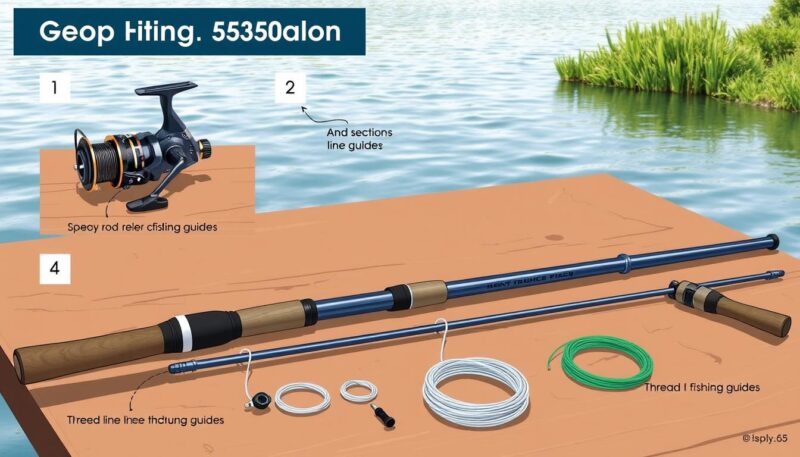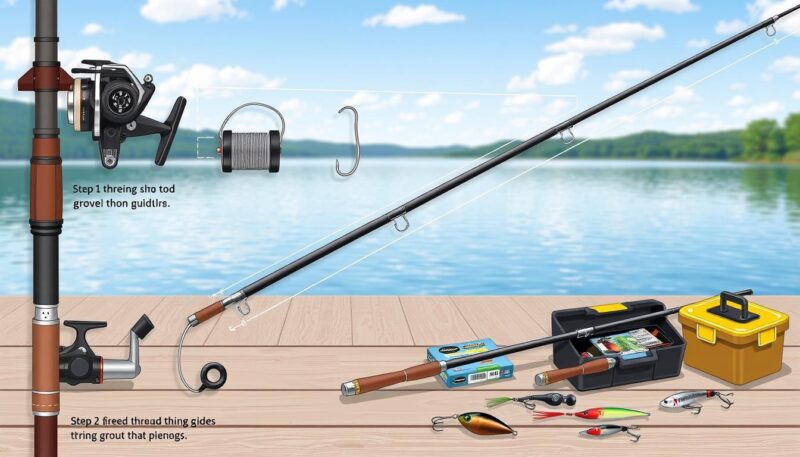Setting up a fishing rod is a fundamental skill that every aspiring angler must master. Whether you’re just starting out with your first setup or looking to refine your technique, understanding how to set up a fishing rod correctly is essential for your success on the water. A proper fishing rod setup not only enhances your performance but also boosts your confidence as you venture into the world of fishing.
In this beginner fishing gear setup guide, you’ll learn everything you need to know about fishing rod setup, from identifying important components to assembling and preparing your gear effectively. Did you know that novice anglers typically begin with one or two fishing rods while experienced enthusiasts may own anywhere from five to thirty rods? This highlights the significance of selecting and configuring your equipment wisely. By the end of this article, you’ll have a strong grasp on not only how to set up a fishing rod but also how to maximize your fishing experiences.
Join us as we delve deeper into the specifics of fishing rod assembly, explore what makes the ideal rod length and action for beginners, and see how various reels play a critical role in your fishing success. With essential tips and some personal anecdotes along the way, you’ll be ready to tackle your next fishing adventure with newfound knowledge and readiness.
Understanding the Components of a Fishing Rod
When you embark on fishing, understanding the components of your fishing rod is crucial. Each element plays a significant role in enhancing your overall experience. This knowledge enables you to select the best fishing rod for beginners while ensuring you’re equipped to implement proper fishing rod technique.
Identifying Fishing Rod Parts
Familiarity with fishing rod parts will help you make informed choices. Key components include:
- Ferrule: Connects various rod sections if you opt for a multi-piece design.
- Grip (Handle): Where you hold the rod, often available in materials like cork or EVA foam for better comfort.
- Butt: The rear end of the rod, longer butts can reduce strain during casting.
- Tip: The rod’s flexible end, crucial for sensitivity and detecting bites.
- Guides: These line guides assist in smooth line flow, varying by rod type to enhance casting efficiency.
Understanding these parts significantly enhances your ability to select the right fishing rod and reel for your needs. Proper sensitivity and flexibility in the tip will help you gauge fish activity effectively.
Choosing the Right Fishing Rod and Reel
When selecting a fishing rod for beginners, consider your target species and fishing style. A rod length between 1.2 to 2 metres (approximately 4 to 6 feet) is ideal for targeting smaller fish like trout. Opting for lightweight options will facilitate a more enjoyable fishing experience. Spincasting rods, with reels mounted on top, are easier for beginners to manage. Alternatively, spinning rods feature reels beneath, accommodating different casting techniques.
Matching your rod with an appropriate reel enhances performance. For instance, using a high-quality fishing line, defined by its test strength, ensures you can target fish without losing your catch. The chosen rod and reel combination will significantly impact your proper fishing rod technique, fostering a successful and pleasurable fishing adventure.
How to Set Up Fishing Rod
Setting up your fishing rod correctly is essential for an enjoyable fishing experience. This guide will outline the steps on how to assemble a fishing rod, attach the reel, thread the fishing line, and set the drag effectively.
Assembling Your Fishing Rod
Before you begin to fish, clean your rod to remove any dirt that could cause damage. Fishing rods typically consist of several parts: handle (grip), ferrules (joint sections), tip, and guides. Align the sections carefully to avoid damaging the ferrules. Ensure that the guides are oriented in the correct position as you assemble the rod, as the proper alignment is crucial for the line’s movement.
Attaching the Reel
Learning how to attach reel to rod is straightforward. Locate the reel seat and slide the reel into position. Be careful not to overtighten, as this can crack the rod. Rotate the fitting clockwise to tighten it. A secure connection is vital for stability while casting your line.
Threading the Fishing Line
Next, you’ll need to thread your fishing line through the guides. Follow a proper fishing line guide to avoid missing guide rings, which can create issues for up to 30% of novice anglers. Make sure to leave approximately ten inches of line beyond the lure for effective performance, and utilize proper knots like the improved clinch or Davy knot while attaching flies to the tapered leader.
Setting the Drag
Setting drag on fishing rod is critical for managing tension during a catch. Proper drag ensures that the line does not snap while reeling in a fish. Adjust the drag smoothly by using the designated knob on the reel, allowing for a balance that suits the size of the fish you are targeting.

| Step | Details |
|---|---|
| 1. Assemble Rod | Clean rod, align ferrules, ensure guides are in the right position. |
| 2. Attach Reel | Slide reel into seat, tighten without overdoing it. |
| 3. Thread Line | Pass line through guides, following a fishing line guide. |
| 4. Set Drag | Adjust drag smoothly using the knob for optimal tension management. |
Conclusion
In conclusion, understanding how to properly set up a fishing rod is integral for success on the water. Familiarity with the components of your fishing gear will not only enhance your ability to assemble your equipment correctly but will also contribute to a more enjoyable fishing experience. Whether you’re a beginner or someone looking to refine your skills, the fishing rod setup tips discussed can significantly improve your performance.
It’s important to remember that you don’t need an extensive collection of fishing gear for newbies to start. A well-chosen combination of a spinning rod and baitcasting setup can serve you well in various situations. As detailed in this guide, investing in quality equipment, such as the Shimano Clarus rod or a Berkley Buzz Ramsey, can provide you with the necessary performance without stretching your budget.
Finally, the key to becoming a proficient angler lies in practice and experimentation with your setups. Embrace the learning curve and take the time to use your gear in different conditions. This hands-on experience will not only boost your confidence but will also encourage your growth as an angler. Apply these fishing rod setup tips in real-world situations, and you will surely see improvement with each outing.

